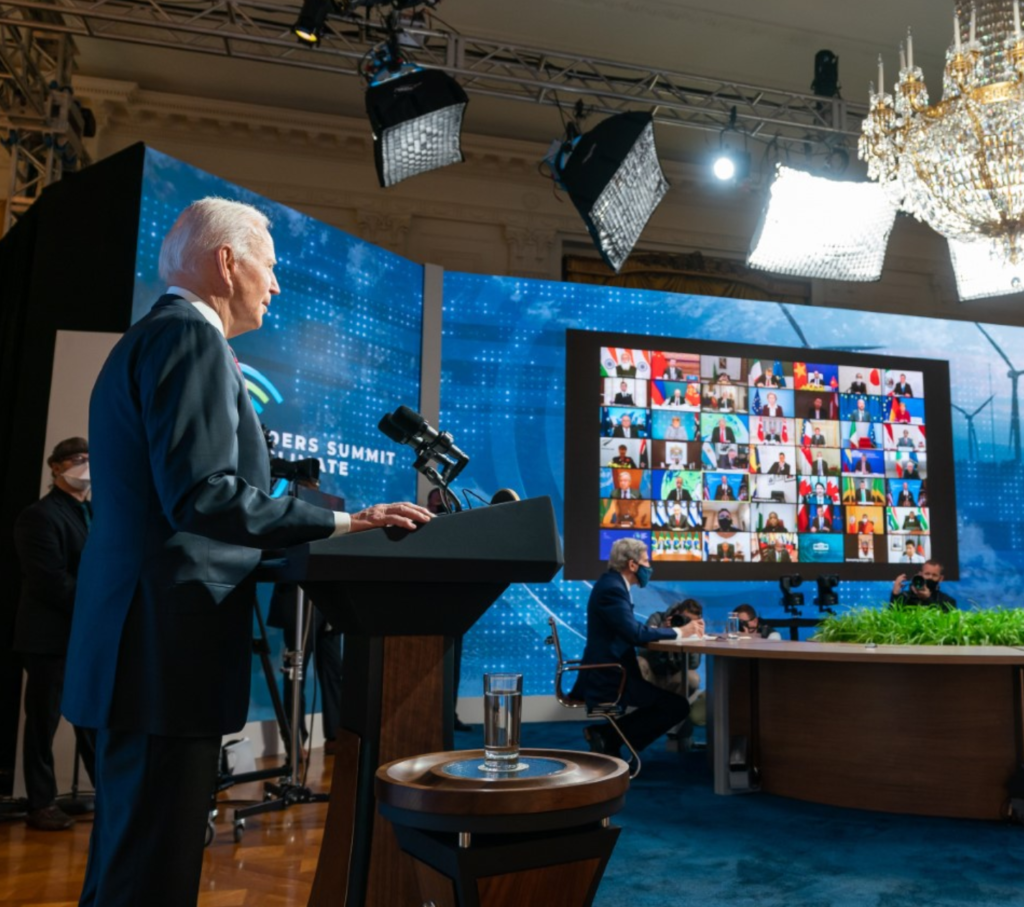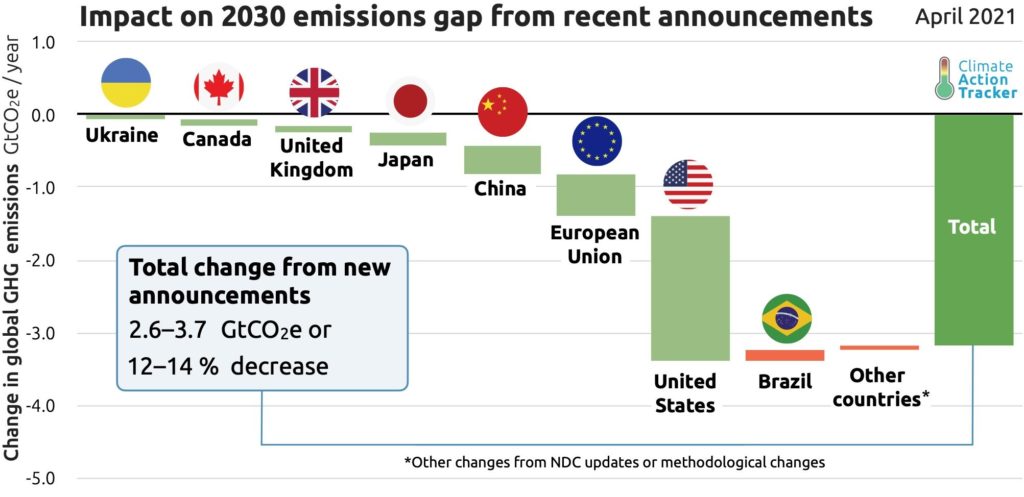Leaders Summit on Climate: headlines and LDC, AOSIS response

President Biden’s Leaders’ Summit on Climate may have delivered a shot in the arm for climate ambition – but indicators of global warming show the planet is in deep peril, and least developed and small island nations say rich nations have failed to make sufficient funding pledges to help vulnerable people. Mairi Dupar of CASA reports.
The Government of the United States has geared up its climate ambitions by pledging to reduce economy-wide emissions by 50 – 52% below 2005 levels by 2030.
President Joe Biden made the announcement at the Leaders’ Summit on Climate (watch here on youtube), which he convened virtually on Earth Day, 22 April 2021.
President Biden had marked his first day in office by taking the U.S. back into the Paris Agreement – and this new pledge on emissions reductions marked the conclusion of his first 100 days in office.
The U.S. is the world’s second-largest emitter and is responsible for 15 percent of global emissions. The new pledge – if achieved – will make a real difference to the world’s progress towards the Paris goals.
The Leaders’ Summit also created a platform for other high-emitting nations to announce their pledges for greater emissions reductions. President Biden cast world leaders’ task as a ‘race to the top’ :
“The signs [of climate change] are unmistakable, the science is undeniable, the cost of inaction keeps mounting,” he said. “Those that do take action, that make bold investments in their people, in their energy future, will win the good jobs of tomorrow and make their economies more resilient and more competitive. So let’s run that race…win a more sustainable future than we have now, overcome the existential crisis of our time.”
Nudging down the dial on emissions
As well as the United States’ headline commitment, several other large emitters made enhanced climate pledges at the Summit. According to official State Department reports:
- The European Union is putting into law a target of reducing net greenhouse gas emissions by at least 55% by 2030 and a net zero target by 2050.
- Japan will cut emissions 46 – 50% below 2013 levels by 2030, with strong efforts toward achieving a 50% reduction, a significant acceleration from its existing 26% reduction goal.
- Canada will strengthen its NDC to a 40 – 45% reduction from 2005 levels by 2030, a significant increase over its previous target to reduce emissions 30% below 2005 levels by 2030.
- China indicated that it will join the Kigali Amendment, strengthen the control of non-CO2 greenhouse gases, strictly control coal-fired power generation projects, and phase down coal consumption. (Source: US Dept of State) [China also announced last September that it will aim to peak greenhouse gas emissions by 2030 and achieve carbon neutrality by 2060.]
- Meanwhile, the United Kingdom announced it would count aviation and shipping in its national emissions targets for the first time and set a target to reduce greenhouse gas emissions by 78% by 2035 in keeping with the legal requirements of its carbon budget.
Welcome action – but against a solemn backdrop
The Summit occurred against a backdrop of bad news in the battle against climate change:
- An Initial NDC Synthesis Report released by the UNFCCC two months ago looked at the ambition of new or updated Nationally Determined Contributions (NDCs) — which were submitted by 75 countries by the end of 2020. These come from around 40% of Parties to the Paris Agreement. The UNFCCC calculated that if countries implement the targets in the new or updated NDCs, their projected emissions will be, by 2030, only 0.5 per cent lower than in 2010. Whereas, “to be consistent with global emission pathways with no or limited overshoot of the 1.5°C goal, global net anthropogenic CO2 emissions need to decline by about 45 per cent from the 2010 level by 2030, reaching net zero around 2050.” This gap between countries’ commitments and the reductions actually needed for a 1.5°C world is called the ’emissions gap’.
- The World Meteorological Organization issued its State of the Global Climate 2020 days before the Leaders Summit. This report concludes: “Covid-19 combined with extreme weather [created] a double blow for millions but failed to put a brake on climate change and its accelerating impacts.” In its foreword, UN Secretary General Antonio Guterres wrote: “2020 was an unprecedented year for people and planet: …global temperatures higher than in a millennium; and the highest concentration of carbon dioxide in our atmosphere for over 3 million years.”
- Although many people had hoped that the lockdowns forced by the pandemic would lead to sustained downturns in global emissions, emissions could be on a dangerous rebound. The latest analysis by the International Energy Agency (IEA) forecasts that global emissions in 2021 are set to rise by the second largest amount in history. “Global carbon emissions are set to jump by 1.5 billion tonnes this year – driven by in the resurgence of coal use in the power sector. This is a dire warning that the economic recovery from the Covid crisis is currently anything but sustainable for our climate,” said Fatih Birol, the IEA Executive Director.
What does it all add up to?
An infographic and analysis released by the Climate Action Tracker show that “[The] climate action announcements at US President Biden’s Leaders’ Summit on Climate, together with those announced since September last year, have narrowed the 2030 emissions gap by around 12 – 14%, according to a provisional post-Summit analysis by the Climate Action Tracker. The largest contributions came from the U.S., the EU+UK, China and Japan.”
However, there is still a very large amount of work to do, to align global emissions with the 1.5°C temperature goal of the Paris Agreement. The graph by Climate Action Tracker (below) shows how global emissions need to drop in the next decade. The blue dotted line shows projected 2030 emissions levels, based on (left arrow) countries’ pledges and targets in September 2020, compared with (right arrow) estimates of the collective pledges and targets made by April 2021.

Climate scientist Stefan Rahmsdorf added: “How much warming do we expect after the latest pledges and targets announced at the Biden climate summit? The Climate Action Tracker is the go-to source for this. They show: the emissions gap is reduced by ~3 Gt [Gigatons of carbon dioxide equivalent], but still over 20 Gt to go.”

What least developed and small island countries are saying
Before the Leaders Summit, UNFCCC Executive Secretary Patricia Espinosa had remarked that “current levels of climate ambition are very far from putting us on a pathway that will meet our Paris Agreement goals” and that “an increase in ambition must be accompanied by a significant increase in support for climate action in developing nations, fulfilling a key element of the Paris Agreement.”
The lack of notable new finance for Least Developed Countries (LDCs) was a theme that resonated after the conclusion of the Leaders Summit, too. LDC Group Chair Sonam Wangdi of Bhutan, who represents more than a billion people in 47 LDCs, issued a statement praising President Biden’s emissions reductions target, and the US commitment to double public climate finance and triple adaptation finance by 2024.
However, the “support must not end there,” H.E. Wangdi said. “The LDCs are counting on support from the whole international community to help implement our ambitious climate plans that will safeguard the lives and livelihoods of our people and their children, allowing us all to thrive with nature.”
“Developing countries and particularly LDCs must be provided with support measures to address the climate crisis. Our people are already suffering. The billion people we represent need more than talk. We need urgent climate action.”
A statement by the Alliance of Small Island States stressed the particular circumstances of its members:
“The economic situation of our countries was already grave before the COVID-19 pandemic. It is now dire, particularly for tourism dependent nations. We are literally teetering on the edge of despair. Over the years, the debt of small states has risen to unsustainable levels, because of repeated borrowings to rebuild and recover from continuous debilitation by natural disasters, arising from climate change. Mechanisms, introduced by International Financial Institutions (IFIs), for addressing the looming debt crisis are insufficient.”
The AOSIS statement adds that “to design new and enhanced financial instruments and to provide debt relief, including debt cancellation, debt suspension, debt rescheduling, debt restructuring and debt-for-climate swaps.”
Without tailored and much increased financial assistance for Small Island Developing States, Prime Minister Browne of Antigua and Barbuda concluded, after the Summit: “we congratulate the US on their much improved 2030 target and commitment toward climate financing…but it is not yet enough to give our islands a fighting chance.”